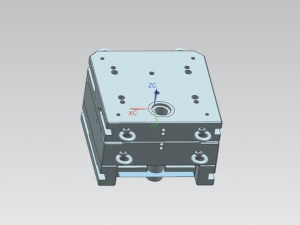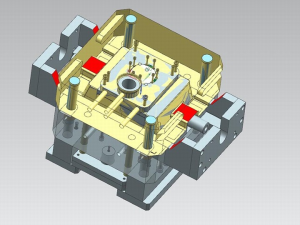Preventing mold failure is a long-term and arduous task. These seemingly small problems will bring unexpected risks in the automated production process, resulting in batch waste of products and unnecessary economic losses to enterprises. Therefore, from Sufficient attention must be paid to the design stage of aluminum die-casting mold production.
1. The automation of die-casting production by hydraulic cylinders instead of inclined guide columns includes the automation of release agent spraying. Currently, the commonly used sprayers are mostly 2-axis servo system sprayers and old-fashioned copper tube nozzle sprayers (of course, there are also a few using robot sprayers). These two sprayers The nozzle of the system basically enters vertically from the top of the mold after parting. According to the instructions of the control system, the nozzle moves up and down at a certain speed to remove the movable mold and fixed mold surface of the mold within a certain time. Injection and blow molding. Since the nozzle needs to enter from the top surface of the mold, the original inclined guide column core pulling device designed above the mold must be changed to a hydraulic cylinder core pulling device, otherwise it will affect the action of the nozzle and even damage the nozzle.
Since automatic spraying is carried out according to preset programs, the spraying process is far less flexible than manual spraying, and "special attention" cannot be achieved for parts that require an appropriate spray amount, especially large sliders. For example, after the mold is opened, the sliding The back of the block is still blocked by itself and cannot be effectively sprayed.
2. Among the die casting process parameters, the mold temperature of the cooling system is a very important parameter. It will affect a series of factors such as the appearance quality of the casting, filling time, filling speed, pressure transfer, etc. It can be said that the correct and constant High mold temperature is the key to ensure reliability. This is the basic premise for producing high-quality castings, increasing productivity, reducing scrap rates and extending tool life. Automated production brings increased production tact, which will inevitably lead to increased mold temperature. In addition, compared with manual spraying, the automatic spraying time is shortened, which further increases the mold temperature. Therefore, the design requirements for the die-casting mold cooling system in the automatic production process will be more stringent, and the arrangement of cooling water channels and the setting of spot cooling must be Scientific and reasonable. Adapt to the new situation of die casting production. The mold temperature must be within a reasonable, uniform and controllable range to ensure stable and reliable casting quality.
3. The reliability of the mold core is mainly reflected in two aspects: one is bending fracture, and the other is core retreat. For the bending fracture of the iron core, the measures we can take are: ① Strictly control the aspect ratio of the small core, reduce the The possibility of core bending. ② The gate in the mold avoids directly impacting the small core of the mold. ③ Minimize the chamfer of the core hole, avoid the use of stepped core, and eliminate the local stress concentration of the core, as shown in Figure 3. ④ Use high-quality steel and proper heat treatment process to improve the production quality of small cores. ⑤ Surface treatment of small cores to reduce the clamping force of the cores.
During use, the retreat of the core mainly occurs on the quick-change core; under normal circumstances, the tail of the quick-change core is fixed with a fixing screw with an inner 6-corner conical end, and the screw will loosen during use, or replace the type The screw is not tightened after the core, which causes the core to retreat during the die-casting production process. The common solution is to increase the number of fixing screws at the inner 6-corner end to 2, and at the same time strengthen the inspection and acceptance work after the mold is repaired, which can basically ensure that the core does not retreat. .
4. Stability of the ejector system The design of the ejector system of the mold involves a lot of calculations. In most cases, the mold factory will set the number, diameter and thickness of the ejector plate based on experience. There is little to check the stability of the ejector pin and Deformation of the ejector plate. In the process of use, mold damage caused by the bending and fracture of the ejector rod often occurs. The deformation of the top plate causes the depth of the ejector pin marks on the surface of the casting to exceed its depth, which avoids the scrapping of the casting due to machining allowance. Therefore, in order to adapt to die casting In order to automate the production of parts, it is necessary to make the necessary calculations for the stability of the ejector and push areas to prevent problems.
The stability of the ejector system also includes the setting of the ejector plate return limit block. At present, most return limit blocks use a circular limit. The contact area between the limit block and the ejector plate is small. After long-term use, The deformation of the limit block makes the limit of the ejector plate unreliable, and the trace of the ejector pin is higher than the surface of the casting, which sometimes affects the positioning of subsequent processing. The reliability, in severe cases, the casting will be scrapped.
The setting of the ejector rod should try to prevent some parts of the casting from sticking to the mold, and if necessary, an auxiliary device should be set up to automatically inject oil into the ejector rod to avoid frequent jamming of the ejector rod and ensure the smooth ejection of the casting.
Although these necessary measures have been taken in the process of making and using aluminum die-casting molds, these measures are not done once and for all. In particular, various changes will occur during the use of molds. Die-casting enterprises must also do a good job in the daily routine of die-casting molds. Maintenance work. Record the use and maintenance of the die-casting mold throughout its service life; summarize and analyze the failure rules during the use of the die-casting mold, and regularly replace the vulnerable small cores, injectors and other accessories according to these use rules. Carry out preventive maintenance to lay a good foundation for the automated production of die castings.





